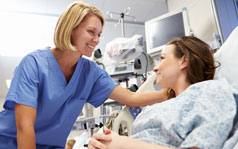Laparoscopic Sleeve Gastrectomy
Contact Us
Please note that a referral letter is required before an appointment can be confirmed.
Useful Information
About this process
Unlike a gastric bypass, the route that food takes following a laparascopic sleeve gastrectomy (LSG) is the same as before surgery. The remaining stomach tube, or sleeve, is much smaller than the original stomach and cannot hold as much food. It also produces less of the appetite-regulating hormone ghrelin, which may lessen your desire to eat.
An LSG does not affect the absorption of calories and nutrients in the intestines.
Most people lose weight quickly over the first year following a sleeve gastrectomy. It is common to lose between 50–60% of their excess body weight. Adherence to dietary advice and regular exercise key to achieving greater weight loss and better weight maintenance. The dietitian will discuss changes to make to your eating patterns to achieve the best weight loss results.
- Weight loss starts from the time of surgery
- The amount of food you can eat is restricted
- When you eat you are likely to feel satisfied sooner and for longer
- Your intestines remain intact so food is digested and nutrients are absorbed as normal
- The procedure is effective at reducing medication requirements and improving blood sugar control for patients affected by type 2 diabetes mellitus
- It is major surgery and involves cutting and stapling of the stomach
- It is a permanent, non-reversible procedure
- Your hair may thin temporarily while rapidly losing weight
- Nausea and vomiting may occur, particularly in the first few days after surgery or if you eat too quickly/too much
- You will need to take medication daily to reduce stomach acidity
- Weight regain can occur if you do not adhere to long term dietary, exercise and lifestyle changes
As with any surgery there are possible complications, including:
- Heart attack: obese patients are at increased risk due to higher cardiovascular risk factors such as blood pressure, type 2 diabetes, and high cholesterol.
- General anaesthesia complications: obese patients are at higher risk.
- Pulmonary embolism: this occurs when a blood clot in the leg breaks off and travels to the lungs. In such cases most patients develop sudden shortness of breath but it can cause sudden death in about 1% of patients. You will be put on blood thinning medication and given compression stockings while in hospital to prevent this. The blood thinning medication will need to be continued for two weeks after you are discharged.
- Infection: the risk of infection is generally low. Wound and urinary infections are rare and if they occur, can be treated with antibiotics. Likewise lung infections are rare if you follow post-operative respiratory physiotherapy guidelines. You may be given medication to prevent infections before you go home.
- Ulcers: the risk of ulcer formation significantly increases if you smoke.
- Leaks: leaks can occur where the bowel, stomach and intestine are stapled or sewn. If a complete seal does not form, bowel contents can leak into the abdomen causing a serious infection. This occurs in about 0.5-3% of cases. If a leak is suspected, you may require further surgery.
- Bleeding: bleeding occurs in 3-5% of cases and is usually resolved by stopping any blood thinning medication you are on. Occasionally surgery may be needed to stop the bleeding.
- Gallstones: you may develop gallstones due to rapid weight loss. It may be necessary to undergo a further operation to remove your gallbladder, although this is quite rare.
- Bowel obstruction: this can be caused by scar tissue in the abdomen, kinking of the bowel or the development of an internal hernia. It occurs in up to 5% of cases and a further operation may be needed to correct it.
- Spleen injuries: these are rare but can occur during surgery and in some cases the spleen may have to be removed.
- Incisional hernia: this is rare when using laparoscopic (keyhole) techniques. If it occurs a hernia repair operation will usually be required.
- Death: there is about a 1% risk of death associated with surgery. This can depend on the surgical procedure and your clinical condition.







.jpg?sfvrsn=4ae04bd7_1)


